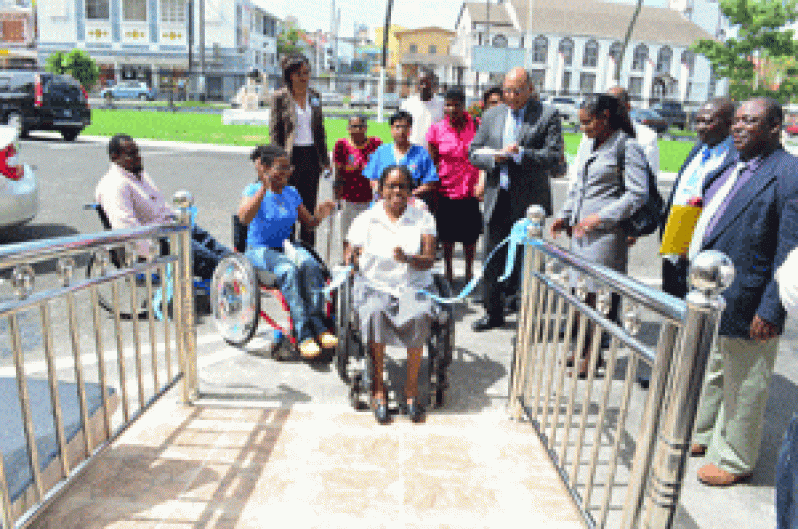– to help disabled persons view parliamentary proceedings
IN the first step to making the Public Buildings accessible to the disabled, a wheelchair ramp was commissioned last Friday.  At the simple, ribbon-cutting ceremony on the ground floor of the historic Public Buildings in Georgetown, to formally commission the ramp of the National Assembly, Speaker Raphael Trotman, in opening remarks, said it was part of an ongoing process to make the Parliament more accessible to all the people of Guyana.
At the simple, ribbon-cutting ceremony on the ground floor of the historic Public Buildings in Georgetown, to formally commission the ramp of the National Assembly, Speaker Raphael Trotman, in opening remarks, said it was part of an ongoing process to make the Parliament more accessible to all the people of Guyana.
He said that since he became Speaker, he has been working with the Clerk of the National Assembly and other staff to ensure as a first step they have a ramp.
“I know that the ramp may be a bit steep, but I believe that with some assistance and some effort, we will get by. We can now access the first floor of the building, and so the next step for us is to put an elevator in; but I believe that they say the longest journey starts with the first step,” he said.
Persons in wheelchairs can now access the first floor of the Public Buildings, and Trotman said he hopes the ramp becomes functional, with the library, the Legislative Department and the Committee Rooms being on that floor.
He said what is left to access is the Parliament Chamber; but, in the interim, given an innovative idea by Alliance For Change (AFC) Member of Parliament (MP) Mrs. Catherine Hughes, when there are sittings of the National Assembly, they will be looking perhaps at setting up a room with a monitor, in which proceedings can be televised.
“I am proud and I am happy that I could be a part of this momentous exercise… It is the first in a number of significant steps that the National Assembly of Guyana hopes to take,” the Speaker of the House stated.
He noted that, in November 2010, former President Bharrat Jagdeo assented to the Persons with Disabilities Act, and the legislation does speak to public accessibility, and “it occurred to me that we, being the place that passed this law, should be one of the first to ensure that we comply if we are going to be an example to others.”
Human Services and Social Security Minister, Jennifer Webster, in brief remarks, commended the Speaker of the National Assembly for the initiative.
“This is significant, because we have legislation here in Guyana; and in Guyana, we are required to have a place where persons who are physically challenged can have access to public buildings etc, and I think we are leading here at the National Assembly by setting the tone,” she said.
Noting that about six percent of the population were persons with disabilities, she said those persons can make a meaningful contribution to society.
“It is important that we recognise that they can play a meaningful contribution to our country’s development, and that they have a role to play, and that is why this afternoon’s activity should be commended; and it is the first step in the right direction, and we hope that resources at some point in time would be made available so that perhaps the Parliament can have an elevator and persons would be able to actually access and see what actually goes on here in the National Assembly,” she said.
“The Government of Guyana, through the Ministry of Human Services and Social Security, is committed to supporting initiatives aimed at improving the quality of life of our differently-abled persons,” Minister Webster assured.
AFC MP Mrs. Catherine Hughes also congratulated the Speaker and staff of the House for the great step taken.
“I think that this is really a very happy occasion, and although it might seem like a very small thing to so many people, it is really a great and a big deal for wheelchair users,” she said.
“We need a lift, and I hope that will come in the near future. But, most importantly, I look forward to the day that a wheelchair user will be sworn in as a Member of Parliament,” she said.
Chairperson of the National Commission on Disability (NCD), Ms. Evelyn Hamilton, said the NCD has a vision for this society “that persons with disabilities should have access to all the rights, and lead full and productive lives”.
She said it was a major step for them when the Persons with Disabilities Bill became an Act in 2010, giving them access to education, health services, sports and recreation, housing and water, and a myriad of other things; and it is modelled on the convention on the Rights of Persons with Disabilities.
She stressed that a bill can become a “dead document” unless there are persons, particularly in key areas, willing to go the extra length to ensure and advocate that the things in the Bill become reality.
“And that is why this ramp that we are cutting the ribbon for today, to me, has more meaning than simply giving access to persons living with physical disabilities access to this building – to me, it is symbolic,” she insisted.
Hamilton said she hopes this will be an example to other agencies, and “they will follow this example in the very near future”.
Ramp installed at Public Buildings
SHARE THIS ARTICLE :
Facebook
Twitter
WhatsApp




.jpg)









